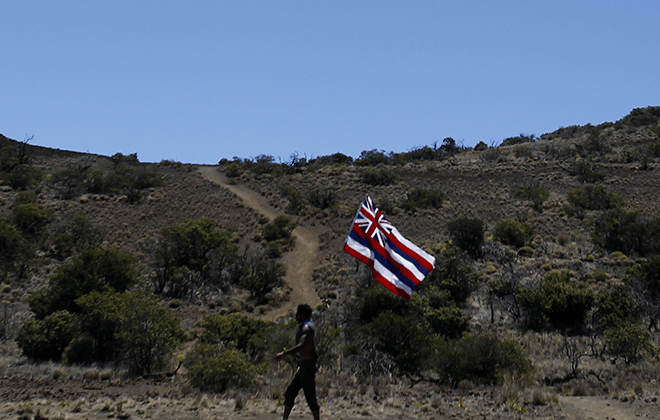The state Department of Land and Natural Resources is gearing up to enforce a new emergency rule that restricts nighttime access to the Mauna Kea summit area.
The rule, approved by the state Board of Land and Natural Resources nearly three weeks ago, is aimed at the Mauna Kea “protectors” who have maintained a vigil at the 9,200-foot level in an effort to prevent construction of the Thirty Meter Telescope.
“Don’t fear, we’re not going anywhere. (The state) put up these new rules, these silly rules. But we’re still here.”
Lanakila Mangauil
From a Facebook video post recorded at the encampment near the visitor center
|
Telescope opponents have vowed to ignore the rule, and a group of five to 30 has continued to maintain a camp near the Maunakea Visitor Information Station for the past four months.
The 120-day emergency rule restricts access to anyone not traveling in a vehicle on Mauna Kea Access Road from 10 p.m. to 4 a.m. It also prohibits camping gear — including tents, sleeping bags, camping stoves and propane burners — within 1 mile of the road at any time.
Dan Dennison, DLNR spokesman, said he couldn’t say when Division of Conservation and Resources Enforcement officers would begin their enforcement action. But, he added, it will happen sometime within the 120-day window of the emergency rule.
“Enforcement can happen any time,” he said.
Dennison said the state has also decided to restrict the media’s access during any enforcement action. The decision, he said, was made in part because of the difficult logistics of carrying out a mission late at night.
Last week, the state installed road signs and put up fliers warning of the new emergency rule. Enforcement officers have also visited the roadside encampment on several occasions over the past week, warning that enforcement can start any time.
Dennison said officers are trying to be patient yet firm, making sure the protesters understand the various parts of the new rule.
Officers also have been distributing a list of all the activities that are prohibited in the area without a permit. They include camping, parking outside designated parking stalls, dumping rubbish, engaging in commercial activity and construction. Violators are subject to a $2,500 fine.
Protest leaders couldn’t be reached for comment Wednesday, but Lanakila Mangauil told his followers Wednesday in a video posted on Facebook that group members would continue their vigil to protect a mountain they consider sacred.
THE RULES
The 120-day emergency rule:
» Bars access by anyone not traveling in a vehicle on Mauna Kea Access Road from 10 p.m. to 4 a.m.
» Prohibits camping gear, including tents, sleeping bags, camping stoves and propane burners, within 1 mile of the road.
Activities prohibited without a permit include:
Camping, parking outside of designated parking stalls, dumping of rubbish, engaging in commercial activity and construction.
Violators are subject to a $2,500 fine.
|
“Don’t fear, we’re not going anywhere,” he said at the encampment across from the visitor center. “(The state) put up these new rules, these silly rules. But we’re still here.”
The protesters have been telling DLNR officers that they have no jurisdiction over their activities and have directed them to take their notifications to officials with a Native Hawaiian government, according to online reports.
State officials said the emergency rule restricting nighttime access was necessary to restore order at the summit.
In asking the Land Board for passage of the rule, they offered up a laundry list of problems compiled in activity logs maintained by visitor center officials and Office of Mauna Kea Management rangers.
The problems included threats of violence against TMT workers, glaring and staring at center staff members, harassing visitors and staff, vandalizing the bathrooms, disrupting center operations and blocking the road.
The visitor center was being so taxed by the members of the protest encampment that it was costing thousands of additional dollars to run the facility each month, they said. For those reasons, the station was shut down June 24 and remains closed.
State officials said that even with all the problems, what ultimately led to the emergency rule was the June 24 protest that blocked a TMT convoy from heading up the mountain to restart construction. Twelve protesters were arrested and hundreds of rocks and boulders were spread out over the gravel roadway, endangering the employees who work at the summit and prompting a road closure for safety reasons.
When and if construction resumes, the $1.4 billion TMT is expected to be one of the largest and most powerful telescopes in the world when it becomes operational in about 2024. The giant, 18-story “next-generation” observatory will have a telescope capable of seeing more than 13 billion light-years away.

